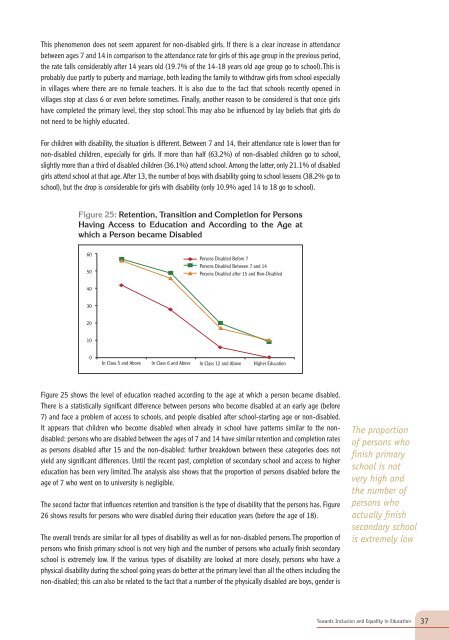Handicap International experience in Afghanistan - CBM
Handicap International experience in Afghanistan - CBM
Handicap International experience in Afghanistan - CBM
- No tags were found...
You also want an ePaper? Increase the reach of your titles
YUMPU automatically turns print PDFs into web optimized ePapers that Google loves.
This phenomenon does not seem apparent for non-disabled girls. If there is a clear <strong>in</strong>crease <strong>in</strong> attendancebetween ages 7 and 14 <strong>in</strong> comparison to the attendance rate for girls of this age group <strong>in</strong> the previous period,the rate falls considerably after 14 years old (19.7% of the 14-18 years old age group go to school). This isprobably due partly to puberty and marriage, both lead<strong>in</strong>g the family to withdraw girls from school especially<strong>in</strong> villages where there are no female teachers. It is also due to the fact that schools recently opened <strong>in</strong>villages stop at class 6 or even before sometimes. F<strong>in</strong>ally, another reason to be considered is that once girlshave completed the primary level, they stop school. This may also be <strong>in</strong>fluenced by lay beliefs that girls donot need to be highly educated.For children with disability, the situation is different. Between 7 and 14, their attendance rate is lower than fornon-disabled children, especially for girls. If more than half (63.2%) of non-disabled children go to school,slightly more than a third of disabled children (36.1%) attend school. Among the latter, only 21.1% of disabledgirls attend school at that age. After 13, the number of boys with disability go<strong>in</strong>g to school lessens (38.2% go toschool), but the drop is considerable for girls with disability (only 10.9% aged 14 to 18 go to school).Figure 25: Retention, Transition and Completion for PersonsHav<strong>in</strong>g Access to Education and Accord<strong>in</strong>g to the Age atwhich a Person became Disabled6050Persons Disabled Before 7Persons Disabled Between 7 and 14Persons Disabled after 15 and Non-Disabled403020100In Class 5 and Above In Class 6 and Above In Class 12 and Above Higher EducationFigure 25 shows the level of education reached accord<strong>in</strong>g to the age at which a person became disabled.There is a statistically significant difference between persons who become disabled at an early age (before7) and face a problem of access to schools, and people disabled after school-start<strong>in</strong>g age or non-disabled.It appears that children who become disabled when already <strong>in</strong> school have patterns similar to the nondisabled:persons who are disabled between the ages of 7 and 14 have similar retention and completion ratesas persons disabled after 15 and the non-disabled: further breakdown between these categories does notyield any significant differences. Until the recent past, completion of secondary school and access to highereducation has been very limited. The analysis also shows that the proportion of persons disabled before theage of 7 who went on to university is negligible.The second factor that <strong>in</strong>fluences retention and transition is the type of disability that the persons has. Figure26 shows results for persons who were disabled dur<strong>in</strong>g their education years (before the age of 18).The overall trends are similar for all types of disability as well as for non-disabled persons. The proportion ofpersons who f<strong>in</strong>ish primary school is not very high and the number of persons who actually f<strong>in</strong>ish secondaryschool is extremely low. If the various types of disability are looked at more closely, persons who have aphysical disability dur<strong>in</strong>g the school go<strong>in</strong>g years do better at the primary level than all the others <strong>in</strong>clud<strong>in</strong>g thenon-disabled; this can also be related to the fact that a number of the physically disabled are boys, gender isThe proportionof persons whof<strong>in</strong>ish primaryschool is notvery high andthe number ofpersons whoactually f<strong>in</strong>ishsecondary schoolis extremely lowTowards Inclusion and Equality <strong>in</strong> Education37
















